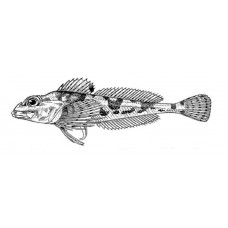Latin name
Triglops murrayi
Other name
Triglops pingelii murrayi, triglops ommatistius, triglops murrayi ommatistius, triglops ommatistius ommatistius, triglops ommatistius terraenovae, triglops murrayi terraenovae, triglops pingelii terraenovae, triglops pingelii var. subborealis, triglops pingelii islandicus, triglops pingelii pietschmanni.
Identification
The moustache sculpin is distinguished by its relatively tall body. The height of the head at the posterior margin of the eye orbit is greater than 15% of the body length. The body is more than 18% as high as the length. The upper jaw protrudes slightly forward. In males, the urogenital papilla is cone-shaped. The folds below the lateral line are broad and regular, though additional folds are sometimes present. There are 42-46 vertebrae.
Features of fish fins
The caudal fin of these fish may be truncated or slightly rounded. In females, the third ray of the pelvic fin is the longest, while in males, it is the second ray. The pectoral fin has a small lower lobe, and the apex is formed by the seventh ray, and occasionally the sixth ray, from below. This blade is more strongly developed in males than in females.
Fish colouring
The moustache sculpin is brown on its back and pale brown to cream on its lower body. It has four blackish-brown, saddle-shaped spots on its back that are rather blurred in some male fish. They have a row of dark brown spots below the lateral line that join to form stripes. Males usually have a distinct black spot on the back of the first dorsal fin. The base of the caudal fin has dark spots on the back and belly. The fin rays are crossed by three to six thin stripes that may be hidden by the overall dark coloration of the fin in males.
Distribution
This species is found in the North Atlantic and the Atlantic sector of the Arctic Ocean. It has been recorded along the coast of Hudson Bay, the southern tip of Baffin Island, and Ungava Bay. It extends south to Cape Cod and east to Greenland. In the eastern Atlantic, it is found along the northern coast of Iceland, extending south to the western and northern coasts of Scotland, the Orkney Islands, the Faroe Islands, and the southern tip of Svalbard and Bear Island. It also occurs along the Scandinavian coast, extending as far as the White Sea.
Habitat
This bottom-dwelling fish inhabits sandy substrates at depths ranging from 7 to 530 meters (23 to 1,739 feet), typically between 100 and 200 meters (330 and 660 feet). It inhabits both benthic and epibenthic habitats.
Size
The maximum published standard length for males of this species is 20 cm (7.9 in), while females reach 15.9 cm (6.3 in).
Behavior
In the Barents Sea, it is found at depths ranging from 50 to 60 meters to 200 to 250 meters (though less often up to 300 meters), in areas influenced by Atlantic waters, with positive bottom temperatures ranging from 2 to 3° and a salinity of at least 34 ‰. In the White Sea, it is found in summer at depths of 7-69 m with positive temperatures (mainly 6-12° in Onega Bay) and low salinity (23.6-28.6 ‰). In other areas, it has been recorded at depths of 19 to 180 meters or more (off Greenland). This species of fish does not migrate.
Food and feeding habits
The moustache sculpin feeds on benthic polychaetes and crustaceans, as well as planktonic crustaceans. The main species are Caprella, Atypus, and Eupagurus.
Reproduction
Spawning occurs in the late fall and winter. The urogenital papilla of the male functions as a sexual organ. In a large female caught in the Barents Sea at a depth of 213 meters (with an absolute length of 120 millimeters), the ovarian eggs measured about 2.2 millimeters in diameter after fixation with alcohol. One of the ovaries contained approximately 120 large eggs and a small number of much smaller eggs. Pelagic fry, measuring 7-15 mm in length, are caught from April to June.
Fishing
This species is not commercially important.
Relationship with a person
Harmless.
| Classification | |
| Phylum | Chordata |
| Class | Actinopterygii |
| Squad | Perciformes |
| Family | Psychrolutidae |
| Genus | Triglops |
| Species | T. murrayi |
| Features | |
| Conservation status | Not Evaluated |
| Habitat | Bottom |
| Life span, years | No information |
| Maximum body weight, kg | No information |
| Maximum length, cm | 20 |
| Sailing speed, m/s | No information |
| Threat to people | Edible |
| Way of eating | Planktonophage |
Moustache sculpin
Tags: moustache sculpin

